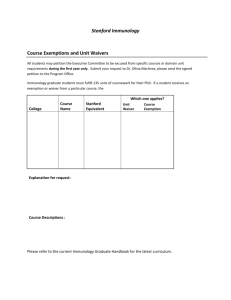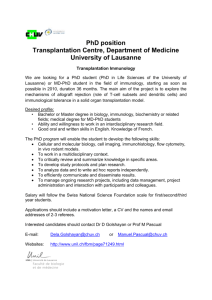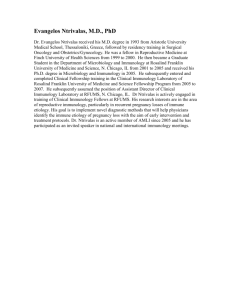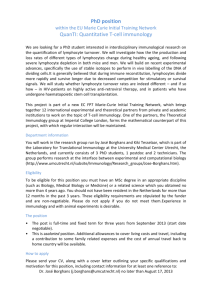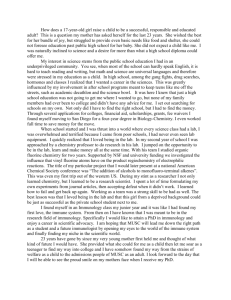Great events in history of transplantation
advertisement
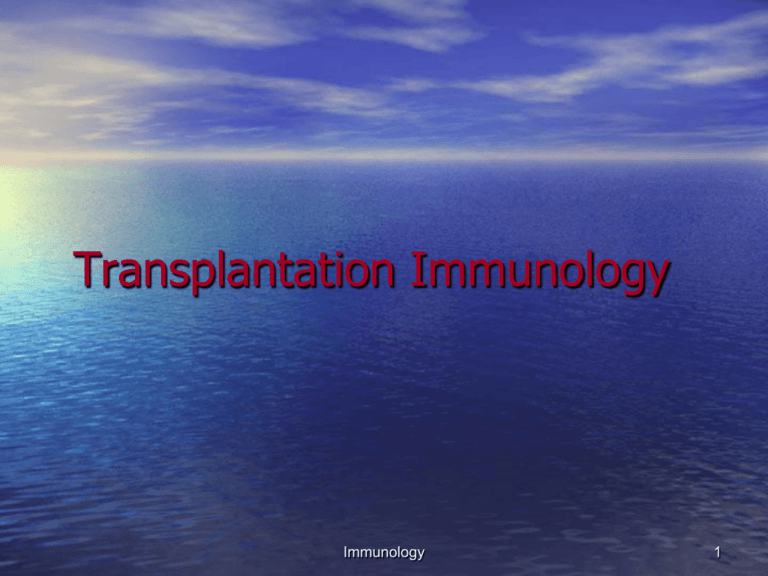
Transplantation Immunology Immunology 1 Introduction Immunology 2 Conceptions • • • • • • Transplantation Grafts Donors Recipients or hosts Orthotopic transplantation Heterotopic transplantation Immunology 3 Nobel Prize in Physiology or Medicine 1912 • Alexis Carrel (France) • Work on vascular suture and the transplantation of blood vessels and organs Great events in history of transplantation Immunology 4 Nobel Prize in Physiology or Medicine 1960 • Peter Brian Medawar (1/2) • Discovery of acquired immunological tolerance – The graft reaction is an immunity phenomenon – 1950s, induced immunological tolerance to skin allografts in mice by neonatal injection of allogeneic cells Great events in history of transplantation Immunology 5 Nobel Prize in Physiology or Medicine 1990 • Joseph E. Murray (1/2) • Discoveries concerning organ transplantation in the treatment of human disease – In 1954, the first successful human kidney transplant was performed between twins in Boston. – Transplants were possible in unrelated people if drugs were taken to suppress the body's immune reaction Great events in history of transplantation Immunology 6 Nobel Prize in Physiology or Medicine 1980 • George D. Snell (1/3), Jean Dausset (1/3) • Discoveries concerning genetically determined structures on the cell surface that regulate immunological reactions – H-genes (histocompatibility genes), H-2 gene – Human transplantation antigens (HLA) ----MHC Great events in history of transplantation Immunology 7 Nobel Prize in Physiology or Medicine 1988 • Gertrude B. Elion (1/3) , George H. Hitchings (1/3) • Discoveries of important principles for drug treatment – Immunosuppressant drug (The first cytotoxic drugs) ----- azathioprine Great events in history of transplantation Immunology 8 Today, kidney, pancreas, heart, lung, liver, bone marrow, and cornea transplantations are performed among non-identical individuals with ever increasing frequency and success Immunology 9 Classification of grafts • Autologous grafts (Autografts) – Grafts transplanted from one part of the body to another in the same individual • Syngeneic grafts (Isografts) – Grafts transplanted between two genetically identical individuals of the same species • Allogeneic grafts (Allografts) – Grafts transplanted between two genetically different individuals of the same species • Xenogeneic grafts (Xenografts) – Grafts transplanted between individuals of different species Immunology 10 Immunology 11 • Grafts rejection is a kind of specific immune response – Specificity – Immune memory • Grafts rejection – First set rejection – Second set rejection Immunology 12 First- and Second-set Allograft Rejection Immunology 13 Part one Immunological Basis of Allograft Rejection Immunology 14 I. Transplantation antigens • Major histocompatibility antigens (MHC molecules) • Minor histocompatibility antigens • Other alloantigens Immunology 15 1. Major histocompatibility antigens • Main antigens of grafts rejection • Cause fast and strong rejection • Difference of HLA types is the main cause of human grafts rejection Immunology 16 2. Minor histocompatibility antigens • Also cause grafts rejection, but slow and weak • Mouse H-Y antigens encoded by Y chromosome • HA-1~HA-5 linked with non-Y chromosome Immunology 17 Immunology 18 3. Other alloantigens • Human ABO blood group antigens • Some tissue specific antigens – Skin>kidney>heart>pancreas >liver – VEC antigen – SK antigen Immunology 19 II. Mechanism of allograft rejection • Cell-mediated Immunity • Humoral Immunity • Role of NK cells Immunology 20 1. Cell-mediated Immunity • Recipient's T cell-mediated cellular immune response against alloantigens on grafts Immunology 21 Molecular Mechanisms of Allogeneic Recognition ?T cells of the recipient recognize the allogenetic MHC molecules ?Many T cells can recognize allogenetic MHC molecules – 10-5-10-4 of specific T cells recognize conventional antigens – 1%-10% of T cells recognize allogenetic MHC molecules Immunology 22 ?The recipient’ T cells recognize the allogenetic MHC molecules • Direct Recognition • Indirect Recognition Immunology 23 Direct Recognition • Recognition of an intact allogenetic MHC • molecule displayed by donor APC in the graft Cross recognition – An allogenetic MHC molecule with a bound peptide can mimic the determinant formed by a self MHC molecule plus foreign peptide – A cross-reaction of a normal TCR, which was selected to recognize a self MHC molecules plus foreign peptide, with an allogenetic MHC molecule plus peptide Immunology 24 • Cross recognition Immunology 25 • Passenger leukocytes – Donor APCs that exist in grafts, such as DC, MΦ – Early phase of acute rejection – Fast and strong Immunology 26 ?Many T cells can recognize allogenetic MHC molecules • Allogenetic MHC molecules (different residues) • Allogenetic MHC molecules–different peptides • All allogenetic MHC molecules on donor APC can be epitopes recognized by TCR Immunology 27 Indirect recognition • Uptake and presentation of allogeneic donor MHC molecules by recipient APC in “normal way” • Recognition by T cells like conventional foreign antigens Immunology 28 Immunology 29 • Slow and weak • Late phase of acute rejection and chronic • rejection Coordinated function with direct recognition in early phase of acute rejection Immunology 30 Difference between Direct Recognition and Indirect Recognition Direct Recognition Indirect Recognition Allogeneic MHC molecule Intact allogeneic MHC molecule Peptide of allogeneic MHC molecule APCs Recipient APCs are not necessary Recipient APCs Activated T cells CD4+T cells and/or CD8+T cells CD4+T cells and/or CD8+T cells Roles in rejection Acute rejection Chronic rejection Degree of rejection Vigorous Weak Immunology 31 Role of CD4+T cells and CD8+T cells • Activated CD4+T by direct and indirect recognition – CK secretion – MΦ activation and recruitment • Activated CD8+T by direct recognition – Kill the graft cells directly • Activated CD8+T by indirect recognition – Can not kill the graft cells directly Immunology 32 Immunology 33 2. Humoral immunity • Important role in hyperacute rejection (Preformed antibodies) – Complements activation – ADCC – Opsonization • Enhancing antibodies /Blocking antibodies Immunology 34 3 .Role of NK cells • CKs secreted by activated Th cells can promote NK activation Immunology 35 Part two Classification and Effector Mechanisms of Allograft Rejection Immunology 36 Classification of Allograft Rejection • Host versus graft reaction (HVGR) – Conventional organ transplantation • Graft versus host reaction (GVHR) – Bone marrow transplantation – Immune cells transplantation Immunology 37 I. Host versus graft reaction (HVGR) • Hyperacute rejection • Acute rejection • Chronic rejection Immunology 38 1. Hyperacute rejection • Occurrence time – Occurs within minutes to hours after host blood vessels are anastomosed to graft vessels • Pathology – Thrombotic occlusion of the graft vasculature – Ischemia, denaturation, necrosis Immunology 39 • Mechanisms – Preformed antibodies • Antibody against ABO blood type antigen • Antibody against VEC antigen • Antibody against HLA antigen Immunology 40 – Complement activation • Endothelial cell damage – Platelets activation • Thrombosis, vascular occlusion, ischemic damage Immunology 41 2. Acute rejection • Occurrence time – Occurs within days to 2 weeks after transplantation, 80-90% of cases occur within 1 month • Pathology – Acute humoral rejection • Acute vasculitis manifested mainly by endothelial cell damage – Acute cellular rejection • Parenchymal cell necrosis along with infiltration of lymphocytes and MΦ Immunology 43 Hyperacute Rejection: the early days • Mediated by pre-existing IgM alloantibodies • Antibodies come from carbohydrate antigens expressed by bacteria in intestinal flora – ABO blood group antigens • Not really a problem anymore Hyperacute Rejection: Today • Mediated by IgG antibodies directed against protein alloantigens • Antibodies generally arise from – Past blood transfusion – Multiple pregnancies – Previous transplantation • Mechanisms – Vasculitis • IgG antibodies against alloantigens on endothelial cell – Parenchymal cell damage • Delayed hypersensitivity mediated by • CD4+Th1 Killing of graft cells by CD8+Tc Immunology 46 Immunology 47 3. Chronic rejection • Occurrence in time – Develops months or years after acute rejection reactions have subsided • Pathology – Fibrosis and vascular abnormalities with loss of graft function Immunology 49 • Mechanisms – Not clear – Extension and results of cell necrosis in acute rejection – Chronic inflammation mediated by CD4+T cell/MΦ – Organ degeneration induced by non immune factors Immunology 50 Immunology 51 Kidney Transplantation----Graft Rejection Immunology 52 Chronic rejection in a kidney allograft with arteriosclerosis Immunology 53 II.Graft versus host reaction (GVHR) • Graft versus host reaction (GVHR) – Allogenetic bone marrow transplantation – Rejection to host alloantigens – Mediated by immune competent cells in bone marrow • Graft versus host disease (GVHD) – A disease caused by GVHR, which can damage the host Immunology 54 • Graft versus host disease Immunology 55 • Graft versus host disease Immunology 56 Conditions • Enough immune competent cells in grafts • Immunocompromised host • Histocompatability differences between host and graft Immunology 57 • • • • Bone marrow transplantation Thymus transplantation Spleen transplantation Blood transfusion of neonate In most cases the reaction is directed against minor histocompatibility antigens of the host Immunology 58 1. Acute GVHD • Endothelial cell death in the skin, liver, and gastrointestinal tract • Rash, jaundice, diarrhea, gastrointestinal hemorrhage • Mediated by mature T cells in the grafts Immunology 59 • Acute graft-versus-host reaction with vivid palmar erythema Immunology 60 2. Chronic GVHD • Fibrosis and atrophy of one or more of the organs • Eventually complete dysfunction of the affected organ Immunology 61 Both acute and chronic GVHD are commonly treated with intense immunosuppresion • Uncertain • Fatal Immunology 63 Part three Prevention and Therapy of Allograft Rejection Immunology 64 • Tissue Typing • Immunosuppressive Therapy • Induction of Immune Tolerance Immunology 65 I. Tissue Typing • ABO and Rh blood typing • Crossmatching (Preformed antibodies) • HLA typing – HLA-A and HLA-B – HLA-DR Immunology 66 • Laws of transplantation Immunology 67 II. Immunosuppressive Therapy • Cyclosporine(CsA), FK506 – Inhibits NFAT transcription factor • Azathioprine, Cyclophosphamide – Block the proliferation of lymphocytes • Ab against T cell surface molecules – Anti-CD3 mAb----Deplete T cells • Anti-inflammatory agents – Corticosteroids----Block the synthesis and secretion of cytokines Immunology 68 Removal of T cells from marrow graft Immunology 69 III. Induction of Immune Tolerance • Inhibition of T cell activation – Soluble MHC molecules – CTLA4-Ig – Anti-IL2R mAb • Th2 cytokines – Anti-TNF-α,Anti-IL-2,Anti-IFN-γ mAb • Microchimerism – The presence of a small number of cells of donor, genetically distinct from those of the host individual Immunology 70 Part IV Xenotransplantation Immunology 71 • Lack of organs for transplantation • Pig-human xenotransplantation • Barrier Immunology 72 • Hyperacute xenograft rejection (HXR) – Human anti-pig nature Abs reactive with Galα1,3Gal – Construct transgenic pigs expressing human proteins that inhibit complement activation • Delayed xenograft rejection (DXR) – Acute vascular rejection – Incompletely understood • T cell-mediated xenograft rejection Immunology 73 Bone Marrow Transplantation • Rescue procedure for hemopoietic reconstitution subsequent to cancer chemo- or radio- therapy Graft vs. Host Disease • Caused by the reaction of grafted mature T-cells in the marrow inoculum with alloantigens of the host • Acute GVHD – Characterized by epithelial cell death in the skin, GI tract, and liver • Chronic GVHD – Characterized by atrophy and fibrosis of one or more of these same target organs as well as the lungs Heart Transplantation Heart transplantation is indicated for those in end-stage heart disease with a New York Heart Association of class III or IV, ejection fractions of <20%, maximal oxygen consumption of (VO2) <14 ml/kg/min, and expected 1-year life expectancy of <50%. Introduction • More than 4000 patients in the United States are • • registered with the United Organ Sharing Network (UNOS) for cardiac transplantation. There are only about 2500 heart donors yearly. Scarcity of donors is complicated by the use of single organs, heart injury with common braindeath injuries, difficulty with ex-vivo preservation, heart disease among donors, and the complexity of the operation. Matching Donor and Recipient • Because ischemic time during cardiac transplantation is crucial, donor recipient matching is based primarily not on HLA typing but on the severity of illness, ABO blood type (match or compatible), response to PRA, donor weight to recipient ratio (must be 75% to 125%), geographic location relative to donor, and length of time at current status. • The PRA is a rapid measurement of preformed reactive anti-HLA antibodies in the transplant recipient. In general PRA < 10 to 20% then no cross-match is necessary. If PRA is > 20% then a T and B-cell crossmatch should be performed. • Patients with elevated PRA will need plasmapheresis, immunoglobulins, or immunosuppresive agents to lower PRA. Heart Transplantation Survival is 80% at five years but at five year 50% also have coronary vascular disease due to chronic rejection. Immunosuppressive Agents • Azathioprine: purine analogue that works by nonspecific suppression of T and B-cell lymphocyte proliferation. • Dosage is 1 to 2 mg/kg per day. • Side effects are bone marrow suppression (dose related), increased incidence of skin cancer (use sunscreen), cutaneous fungal infections, and rarely liver toxicity and pancreatitis. • Drug interactions: allopurinol (decrease dose by 75%) and TMP/Sulfa (worsens thrombocytopenia). Immunosuppressive Agents • Cyclosporin: inhibits T-cell lymphokine production. Highly lipophilic. • Dosage is 8 to 10mg/kg/day in 2 divided doses. IV doses are 1/3 of • • • oral doses in a continuous infusion. Drug levels are frequently measured for dosage and toxicity, but levels are not highly predictive of actual immunosuppressive effect. Drug levels are reflected for 5 to 10 days because of a long half life. Side effects: nephrotoxicity caused by afferent arteriolar constriction and manifested by oliguria. Loop diuretics may exacerbate this side effect. Dosage adjustments should only be made if creatinine level is >3.0mg/dL (some renal insufficiency is expected). Other side effects include hypertension, hypertrichosis, tremor, hyperkalemia, hyperlipidemia, and hyperuricemia. Multiple drug interactions. Immunosuppressive Agents • Corticosteroids: immunosuppressives of uncertain mechanism. Used for maintenance of immunosuppression and to manage acute rejections. • High doses used initially tapered over the 1st 6 months to 5 to 15mg/d prednisone. • Side effects include mood and sleep disturbances, acne, weight gain, obesity, hypertension, osteopenia, and hyperglycemia. Immunosuppressive Agents • Mycophenolate mofetil: selectively inhibits lymphocyte proliferation. • Dosage is 2g/d po. • Side effects include GI disturbances. Does not cause significant bone marrow suppression. • FK-506 (tacrolimus): Lymphophilic macrolide that inhibits lymphokine production similar to cyclosporine. • More toxic than cyclosporine. • Side effects include nephrotoxicity and neuotoxicity. Immunosuppressive Agents • Antilymphocyte globulin: Horse polyclonal antibody designed to inhibit T cells by binding to surface antigens. • It is generally used at the time of transplantation for induction therapy or during acute rejections. • Dosage is 10 to 15 mg/kg qd through a central venous catheter. • Goal is to keep T lymphocyte count ~200cells/microL. • Side effects include fevers, chills, urticaria, serum sickness, and thrombocytopenia. Immunosuppressive Agents • Muromonab-CD3 (OKT3): a murine monoclonal antibody to the CD3 complex on the T-cell lymphocyte designed for selective T-cell depletion. • • • • Usual dose is 5mg/d IV bolus over 10 to 14 days. CD3 cells are monitored with goal <25cells/mL. Used in patients with renal insufficiency. Side effects include cytokine release syndrome (fever, chills, nausea, vomiting, mylagia, diarrhea, weakness, bronchospasm, and hypotension), pulmonary edema. • Rapamycin: Similar mechanism of action of FK-506 except that it antagonizes the proliferation of nonimmune cells such as endothelial cells, fibroblasts, and smooth muscle cells. • Not routinely used at present. • May have a roal in prevention of immunologically mediated coronary allograft vasculopathy. Basic Drug Regimen • Immunosuppressives • Antibiotic prophylaxis • PCP: TMP/Sulfa or Dapsone or Pentamidine aerosols. • CMV infection: Ganglyclovir, acyclovir. • Fungal infections: Nystatin. Antihypertensives • • Diuretics as needed • Potassium and Magnesium replacement (cyclosporin leads to • • • • wasting of thes electrolytes. Lipid-lowering agents. (Avoid allograft vasculopathy). Glucose lowering agents (DM and steroids) Anticoagulation if transplant heterotopic. Cyclosporin dose lowering meds (Diltiazem / Verapamil / Theophyilline) Complications - Rejection • Avoidance with preoperative therapy with • • cyclosporin, corticosteroids, and azathioprine. If rejection is suspected then workup should include: measurement of cyclosporine level CKMB level, echocardiography for LV function, and endomyocardial biopsy. Signs and symptoms of rejection only manifest in the late stages and usually as CHF (rarely arrhythmias). Due to close surveillance, most rejection is picked up in asymptomatic patients. Staging of Acute Rejection • If acute rejection is found, histologic review of endomyocardial biopsy is performed to determine the grade of rejection. • Grade 0 — no evidence of cellular rejection • Grade 1A — focal perivascular or interstitial infiltrate without • • • • • myocyte injury. Grade 1B — multifocal or diffuse sparse infiltrate without myocyte injury. Grade 2 — single focus of dense infiltrate with myocyte injury. Grade 3A — multifocal dense infiltrates with myocyte injury. Grade 3B — diffuse, dense infiltrates with myocyte injury. Grade 4 — diffuse and extensive polymorphous infiltrate with myocyte injury; may have hemorrhage, edema, and microvascular injury. Treatment of Acute Rejection • Grade 1A and Grade 1B: No treatment is necessary. • Grade 2: Probably no treatment is necessary. Short course of steriods (Prednisone 100mg qd x 3 days) is optional. • Grade 3A and Grade 3B: High dose corticosteroids (Solumedrol 1mg/kg IV). If no response then ATGAM (OTK3 also an option, but causes more intense cytokine reaction). • Grade 3 with hemodynamic compromise or Grade 4: High dose corticosteriods plus ATGAM or OTK3. • It is critical that an endomyocardial biopsy be performed to document reversal of rejection after treatment. Otherwise additional agents will need to be added. A biopsy is obtained 1 week after initial biopsy showed rejection and then 1 week after therapy complete. If ATGAM or OTK3 is used biopsy should be obtained at the end of a course of therapy (usually 7 to 14 days) and then again 1 week later off therapy. Complications - Rejection • Allograft vasculopathy (Chronic rejection): Transplant coronary artery disease that is the leading cause of death in patients more than 1 year after transplantation. • Likely a result of a proliferative response to immunologically mediated endothelial injury (chronic humoral rejection). • It differs from native CAD in that it is manifested by concentric stenoses, predominately subendocardial location, lack of calcification, can be rapidly progressive and lack of angina pectoris. • Risk factors include degree of histocompatibility, hypertension, hyperlipidemia, obesity, and CMV infection. Complications – Rejection Allograft Vasculopathy • Treatment is mainly prevention with statins, diltiazem, • • and antioxidant vitamins. Rapamycin is an agent that has shown promise in preventing this complication. Treatment with percutaneous interventions and CABG is limited due to its diffuse nature and subendocardial locations. Retransplantation for this disorder is an option, but retrospective analysis have shown this approach does not improve mortality as patients do significantly worse with a second transplant as compared with the first. Complications - Infection • There are two peak infection periods after transplantation: • The first 30 days postoperatively: nosocomial infections related • to indwelling catheters and wound infections. Two to six months postoperatively: opportunistic immunosuppresive-related infections. • There is considerable overlap, however as fungal infections and toxoplasmosis can be seen during the first month. • It is important to remember that immunosuppressed transplant patients can develop severe infections in unusual locations and remain afebrile. Opportunistic Infections • CMV: most common infection transmitted donor to recipient. • Manifested by fever, malaise, and anorexia. Severe infection can affect the lungs, gastrointestinal tract, and retina. • If donor is CMV positive and the recipient is CMV negative, prophylaxis with IV ganciclovir or foscarnet is given for 6 weeks and followed by longterm oral prophylaxis with acyclovir. • If the recipient is CMV positive a less potent regimen can be used. • Bone marrow toxicity related to treatment can occur and be confused with that due to azathioprine treatment. Complications - Malignancy • Transplant recipients have a 100-fold increase in the prevalence of malignant tumors as compared with age-matched controls. • Most common tumor is posttransplantation lymphoproliferative disorder (PTLD), a type of non-Hodgkin’s lymphoma believed to be related to EBV. • The incidence is as high as 50% in EBV-negative recipients of EBV-positive • hearts. Treatment involves reduction of immunosuppressive agents, administration of acyclovir, and chemotherapy for widespread disease. • Skin cancer is common with azathioprine use. • Any malignant tumor present before transplantation carries the risk for growth once immunosuppresion is initiated because of the negative effects on the function of T-cells. Transplantation Kidney 25,000 patients are waiting for kidney transplantation savings in three years compared to the cost of three years of renal dialysis. Liver One-year survival exceeds 75% and five-year is 70%. Pancreas Transplantation Graft survival is 72% at one-year and this is further improved if a kidney is transplanted simultaneously. The overall goal of pancreas transplantation is to prevent the typical diabetic secondary complications: neuropathy, retinopathy, and cardiovascular disease.
